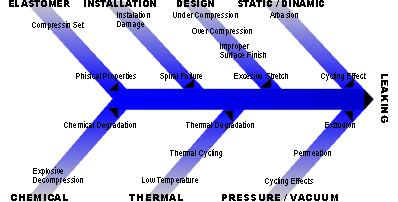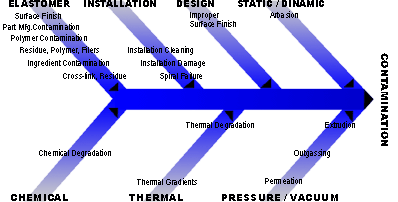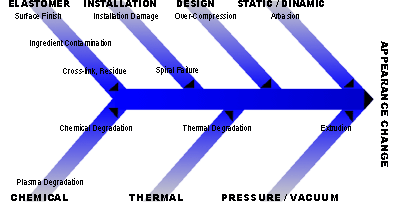O-RING FAILURE ANALYSIS |
O-RING FAILURE ANALYSIS |
|
Prevention of seal failures through proper design, material selection and maintenance certainly minimizes the risk of failure. Attention to the condition of replaced seals, as well as the equipment performance over time, will result in improved process reliability, reduced operating costs and a safer work environment. O-ring seals often fail prematurely in applications because of improper design or compound selection. This section is designed to provide the user with examples of common failure modes. By correctly identifying the failure mode, changes in the design or seal material can lead to improved seal performance. From the end-user�s point of view, a seal can fail in three (3) general ways:
These three effects are demonstrated as Ishikawa (fishbone) diagrams with special emphasis on the following three analysis areas. |
ENVIRONMENT ANALYSIS |
| One major factor in possible seal failure is
the extreme and harsh environment in
which seals are expected to perform. The sealing
environment can consist of virtually
anything from inert gases at room
temperatures to aggressive chemicals at
very high temperatures. The sealing
environment may result in chemical
degradation or swelling of the sealing
components. Elevated temperatures may
cause seal degradation, swelling or
outgassing. And the pressure�or more often, the vacuum
environments�can cause outgassing and weight loss.
Contributing factors to seal failure in the sealing environment include:
|
SEAL DESIGN ANALYSIS |
| Analysis of the seal application is crucial
to the understanding of possible failure.
Most seal design is performed by
component suppliers and equipment
manufacturers. The designs are refined as
experience is gained. As quickly as process
technology changes, however, the
experience gained with seal design may
not be relevant to the latest process
technology. Vacuum applications have
historically relied on high levels of
compression and gland fill to reduce
permeation and trapped gases. These
techniques, when applied to new materials,
or at higher operating temperatures, can
result in premature seal failure.
The seal design and application can provide information about the cause of failure:
|
ELASTOMER ANALYSIS |
| Analytical techniques are used to identify the specific polymer type and compound. They can also be used to identify contam-ination sources on the surface, or surface properties which may have contributed to the failure. Traditional elastomer test methods can determine chemical compatibility, changes in dimension, hardness or physical properties. In vacuum systems, the analysis of outgassing components may lead to the identification of failure mode. ISC can test and coordinate outside laboratory testing to evaluate, identify and recommend solutions to seal failures. The ISC lab is an A2LA accredited test lab for traditional elastomer properties. |
SEAL FAILURE - LEAKING |
 |
SEAL FAILURE - CONTAMINATION |
 |
SEAL FAILURE - APPEARANCE CHANGE |
 |